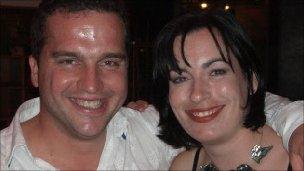Fears over carbon monoxide poisoning figures
- Published

Elisabeth Giauque died after less than three hours' exposure to the gas
The number of deaths and injuries from carbon monoxide poisoning could be significantly higher than official figures show, the BBC has been told.
Health and Safety Executive (HSE) figures show reported deaths to be lower than a decade ago.
But research suggests many cases are missed because medical staff do not routinely test for the poisoning.
The HSE said it accepted there was underreporting in all health and safety matters.
Carbon monoxide is a colourless, odourless and tasteless poisonous gas which is produced when fuel does not burn properly.
It leaks from boilers, gas appliances or flues that have not been properly installed or maintained.
According to the HSE, four people died and 117 fell ill as a result of carbon monoxide poisoning at home in the year to June 2010.
Seventeen people died and 86 became ill the previous year.
But 5 live Investigates has seen research (pdf), external by the Gas Safety Trust charity, which suggests the true figure may be much higher.
As part of the study, the charity looked at a pilot involving ambulance crews in London who were sent out with five carbon monoxide testing kits over a year-long period.
'Knowledge gaps'
They identified 83 people suffering from poisoning in London alone - almost as many as the official figures for the whole of the UK in 2008-09.
Paramedic Andy Humber, who co-ordinated the pilot, said: "We were shocked by the numbers.
"We used two types of testing devices, one used on the pulse and one to test levels of carbon monoxide in the breath.
The pilot has now been extended to teams in Leeds, Manchester and Birmingham, and the charity says that if the London results were replicated across the country, the official figures would "skyrocket".
The trust believes cases are being missed because of a lack of awareness and because pathologists in the UK do not routinely check for carbon monoxide poisoning following every death.
It added: "Overseas research suggests the gaps in our knowledge could be masking significant numbers of carbon monoxide poisoning incidents."
In a statement the HSE told 5 live that "there is a legal requirement to report carbon monoxide poisonings, and while we have confidence in the reports we receive, we accept there will always be a possibility of misdiagnosis".
A spokesman said the organisation also accepted there was under-reporting of health and safety incidents across all sectors.
'Silent killer'
Nicolas Giauque's six-year-old daughter Elisabeth died, external after a faulty boiler at the family's rented home in London leaked out lethal levels of toxic fumes.
Doctors initially thought the little girl was suffering from meningitis.
Mr Giauque said: "Elisabeth was a wonderful little girl.

Vikki Courtman with her boyfriend Robert Schenker, who died from carbon monoxide poisoning
"A couple of hours after she had gone to bed I found her unconscious by the side of her bed. There was no smell, no sign of anything untoward."
He said it took several days to diagnose the carbon monoxide poisoning.
"It's a silent killer. You can't smell it, you can't feel, it you can't see it," he said.
"The second problem is that it has a short life in the blood. The hospital took blood tests as she arrived, but were not looking for carbon monoxide poisoning so didn't notice the elevated level in her blood at that time.
"When they took further blood tests just a few hours later, you can't see it in the blood anymore but it's still in the brain doing damage."
'Increased vigilance'
An investigation later discovered that the levels of carbon monoxide in Elisabeth's blood were so high that even if she had been correctly diagnosed at the outset, she could not have been saved.
Vikki Courtman's 31-year-old boyfriend Robert Schenker died from carbon monoxide, external when the flue became blocked at his home in Peterborough.
Ms Courtman, 35, said: "It took the police and the scientific people three months to find out it was carbon monoxide poisoning.
"They didn't test for it straight away. It's never at the forefront of people's minds when something like this happens."
Concerns about misdiagnosis have been expressed by the chief medical officer Professor Dame Sally Davies, who sent a circular (pdf), external to health professionals in November 2010 warning poisoning was "almost certainly under-diagnosed" and urging "increased vigilance".
In a statement she told 5 live Investigates that recognising CO poisoning was not easy because the symptoms were similar to many other conditions.
She said the Department of Health was working to get better estimates of the number of non-fatal poisonings.
Landlords are required by law to have appliances inspected annually by a qualified engineer, but it is down to the tenant to check the tests have been done.
In many types of private rented accommodation, no statutory body will carry out checks unless a complaint is made or an incident is reported.
Campaigners say the law should be strengthened to include a service of the appliances, as well as a check.
They also want landlords to be forced to fit carbon monoxide detectors in properties.
You can hear the full report on 5 live Investigates on Sunday 17 April at 2100 BST on BBC Radio 5 live. You can also listen again on the BBC iPlayer or by downloading the 5 live Investigates podcast.
- Published14 April 2011
- Published7 April 2011
- Published29 March 2011
- Published2 February 2011